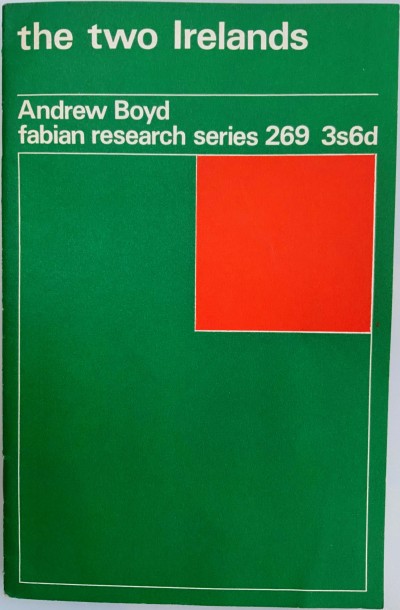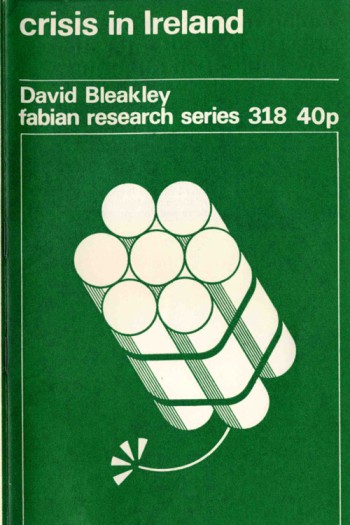The Two Irelands

| Date: | May 1968 |
|---|---|
| Organisation: | Fabian Society |
| Series: | Fabian Research Series, Number 269 |
| Author: | Andrew Boyd |
| Type: | Pamphlet |
| View: | View Document |
| Discuss: | Comments on this document |
| Subjects: |
Please note: The Irish Left Archive is provided as a non-commercial historical resource, open to all, and has reproduced this document as an accessible digital reference. Copyright remains with its original authors. If used on other sites, we would appreciate a link back and reference to The Irish Left Archive, in addition to the original creators. For re-publication, commercial, or other uses, please contact the original owners. If documents provided to The Irish Left Archive have been created for or added to other online archives, please inform us so sources can be credited.
Commentary From The Cedar Lounge Revolution
14th March 2022
As noted before:
The Fabian Society is a British socialist organisation whose purpose is to advance the principles of socialism via gradualist and reformist, rather than revolutionary, means.[1][2] It is best known for its initial ground-breaking work beginning late in the 19th century and continuing up to World War I. The society laid many of the foundations of the Labour Party and subsequently affected the policies of states emerging from the decolonisation of the British Empire, especially India. Today, the society functions primarily as a think tank and is one of 15 socialist societies affiliated with the Labour Party.
This document by Andrew Boyd is a Fabian Research Series pamphlet and was published in May 1968. It offers a fascinating insight into views of Ireland from Britain during this period.
The document has chapters on Partition, Political Parties in the Irish Republic, Political Parties in Northern Ireland, Democracy Modified and Problems of the Economy. A preface notes that this is not the collective view of the Society, but only of the member who prepared it.
In the first chapter it is argued:
It is virtually impossible to write about politics in Ireland without mentioning the extremists-the IRA and Sinn Féin on the one hand, Paisleyism and Ulster Protestantism on the other.
It also argues;
It is not clear what politician originally conceived the idea of partitioning Ireland so as to separate the north-east, where two-thirds of the people are Protestants, from the predominantly Catholic population of the remaining counties. A form of partition was suggested as early as the 1840s when Daniel O’Connell campaigned for repeal of the Act of Union. Partition was mentioned again when Gladstone made up his mind that Ireland should have home rule.
Yet it was never a solution that appealed strongly to Irishmen, either Unionists or Nationalists. This probably explains the duplicity of certain British politicians when they finally decided during the last Home Rule crisis at the beginning of the present century, that partition was the only the answer to the Irish question.
It suggests that:
A United Ireland would, however, be so vastly different from either of the two states that exist in the country today that many of the politicians now in power might not survive long in public life.
Just as the Irish Parliamentary party as swept into oblivion with the rise of Sinn Fein in 1918 so it is conceivable that those political parties which have dominated their separate parts in Ireland since 1920 might be completely be eclipsed in the new Ireland. From this viewpomt Mr Lemass’s plan for a united Ireland with two parliaments is understandable. It is his compromise between national idealism and the need to protect the interests of the power groups in both parts of the country.
There’s much of interest, not least a discussion on discrimination in employment in the North. And this reference to Sinn Féin is intriguing given one of the issues that would convulse that organisation only a year or so later:
In recent years the more militant republicans have revived the old name Sinn Féin but despite the opportunities offered by proportional representation this party has been unable to gain even a foothold in Dáil Éireann.

Comments
No Comments yet.
Add a Comment
Comments can be formatted in Markdown format . Use the toolbar to apply the correct syntax to your comment. The basic formats are:
**Bold text**
Bold text
_Italic text_
Italic text
[A link](http://www.example.com)
A link
You can join this discussion on The Cedar Lounge Revolution
By: benmadigan Mon, 14 Mar 2022 13:40:18
Thanks for that upload.
Andrew Boyd, who was an economist, was very proud of this analysis, which is well worth a careful reading
“It offers a fascinating insight into views of Ireland from Britain during this period.”
This is a correct assessment I think. Boyd was brought up in the Unionist tradition. He would certainly identified with the Labour movement on the whole, though not a member of any political party.
He was certainly realistic and far-seeing in many of his comments Here are 4 out of many I could have chosen to cite
1) “The larger political parties in the southern
part of Ireland (FG and FF) and their ideological
fellow-travellers, the nationalists of the
north (SDLP), are anti-partitionists in theory only.”
(I have added Party names)
2)”Today the Unionists are determined to resist every encroachment on the rights which they have been given under the 1920 Act”.
(See Unionist opposition to the NIP)
3)”Through time cross-border economic cooperation will extend to the promotion of .new industries, to the exploitation of Ireland’s natural resources, including sea and inland fisheries, to technical training,
social services, the promotion of markets abroad, and so on”.
(Isn’t that one of the aims of the GFA?)
4) “Partition need not be an obstacle to Ireland’s
economic progress”.
(After joining the EU partition wasn’t an obstacle for the ROI, but poor progress persists in NI, due in part to British Government policies)
Reply on the CLR